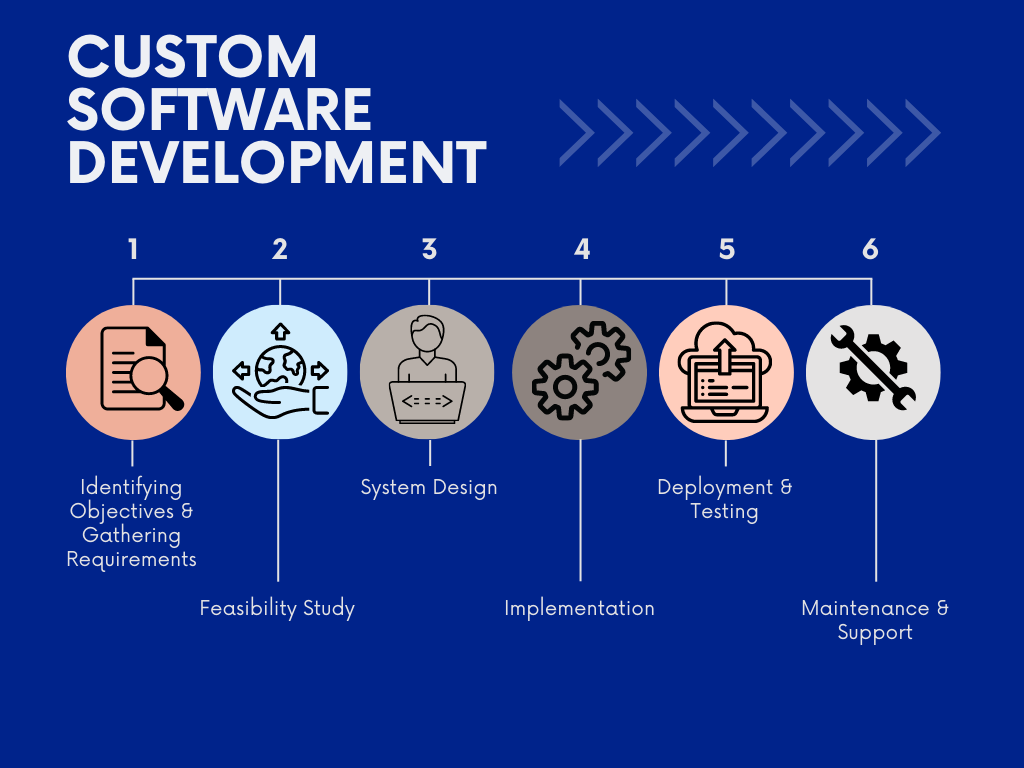Customized Software Application Development: Tailoring Innovation to Meet Your Special Needs
In today's quickly progressing technical landscape, customized software program development stands as a crucial method for companies looking for to fine-tune their operations with precision-crafted services. Unlike generic applications, customized software application aligns closely with specific organization demands, driving effectiveness and competition. The procedure of crafting these solutions involves precise planning and collaboration, ensuring that every practical need is resolved. As enterprises purpose for seamless combination and scalability, the concern develops: how does one guarantee that custom software program not only fulfills current demands yet also anticipates future challenges? This expedition assures understandings right into the calculated worth of bespoke modern technology services.
Recognizing Personalized Software
Personalized software program advancement entails crafting customized software program options to meet the details needs of a business or organization, distinguishing it from off-the-shelf software. While off-the-shelf remedies offer generic performances created for mass charm, personalized software program is thoroughly developed to fit the unique processes, process, and calculated goals of a certain entity. The advancement of personalized software is a complex process that requires a deep understanding of the customer's requirements and the atmosphere in which the software application will operate.
The procedure starts with an extensive analysis of the customer's organization procedures to recognize certain requirements and challenges that the software application must attend to. This is complied with by the design and growth phases, where software program engineers and developers function very closely with stakeholders to make certain alignment with business goals. Unlike basic software, custom software application is flexible, permitting modifications and scalability as the organization evolves.
Moreover, personalized software is established with the company's existing systems in mind, ensuring integration and compatibility across systems. This causes enhanced effectiveness and structured operations. By aligning modern technology with service procedures, custom-made software program empowers organizations to accomplish their purposes with precision and performance, ultimately providing a competitive side in their corresponding industries.
Advantages of Tailored Solutions

In addition, customized software program supplies scalability, a vital advantage for expanding organizations. As a company's needs progress, personalized options can be changed and expanded to suit brand-new performances without disrupting existing operations. This versatility guarantees long-term feasibility and supports future growth.
Protection is another substantial benefit. Custom-made software can be made with robust safety and security procedures tailored to the specific vulnerabilities of the organization, decreasing the threat of cyber hazards. Unlike common software application, which might be targeted by prevalent strikes, custom-made remedies provide a less foreseeable target for cybercriminals.
Key Growth Procedures
Comprehending the benefits of customized software remedies lays the groundwork for discovering the crucial development processes that make such customization possible. Central to these processes are needs collecting, design, growth, screening, and release. Each action is diligently crafted to make sure that the last item straightens flawlessly with the client's distinct objectives.
The process starts with thorough needs collecting, where developers involve in thorough conversations with stakeholders to comprehend their details needs and restrictions. This phase is important for identifying the software program's scope and setting clear assumptions. Following this, the style phase converts these needs into a calculated plan, laying out the software program's design, user interface, and functionalities.
Advancement is the core of the process, where experienced developers compose code based upon the well established design. This stage is iterative, allowing for constant refinement and assimilation of comments. Testing complies with, working as a quality control procedure to identify and correct any type of flaws or disparities.
Collaboration With Developers
Reliable collaboration with programmers is important to the success of custom software tasks. This collaboration guarantees that the end product properly reflects the client's vision and fulfills specific service purposes. Open interaction is the foundation of this cooperation. It involves normal conferences, clear conversations, and using tools that promote information exchange, such as project monitoring software program and communication systems - custom software development. By establishing clear lines of communication, both events can resolve difficulties as they develop and adapt the project to altering demands.
Comprehending the developer's operations is also important. Clients who acquaint themselves with the development procedure can offer even more relevant comments and set practical expectations regarding timelines and deliverables. This good understanding fosters a much more unified connection, where programmers really feel sustained and customers feel informed.
In addition, entailing designers early in the decision-making procedure can substantially improve the project's end result. Developers bring technological competence that can influence strategic decisions, making certain that suggested options are not just possible yet likewise efficient. By valuing their input, clients can harness their creativity additional resources and technical skills to achieve innovative outcomes.
Future-Proofing Your Software
In the ever-evolving landscape of technology, guaranteeing your custom software application continues to be relevant and useful with time is extremely important (custom software development). Future-proofing your software includes critical planning and implementation of versatile solutions that accommodate technical innovations and altering service needs. The secret is to expect prospective changes and incorporate flexibility into your software application design from the beginning
To accomplish this, focus on scalable solutions that permit smooth assimilation of new functions or modules as your business expands. Utilizing modular layout patterns can assist in updates and lessen disruptions. Additionally, embracing open standards and interoperability makes certain that your software can interact properly with other systems, avoiding vendor lock-in and improving adaptability.
On a regular basis updating your innovation stack is also crucial. This entails remaining check that educated regarding arising innovations and sector fads, enabling your software to utilize the most up to date technologies. Aggressive maintenance and extensive screening methods are important to identify and attend to susceptabilities, making certain sustained safety and efficiency.

Conclusion
Custom software program growth offers a strategic advantage by giving solutions distinctively tailored to a company's specific requirements, improving operational performance, scalability, and safety. With precise needs collecting, collective layout, and iterative growth, custom software program makes sure smooth integration with Find Out More existing systems and flexibility to future changes. This strategy not just addresses existing challenges but likewise settings businesses for long-lasting success by advancing along with business development, thereby establishing a durable foundation for sustained technological improvement and affordable side.
 Katie Holmes Then & Now!
Katie Holmes Then & Now! Michael Jordan Then & Now!
Michael Jordan Then & Now! Macaulay Culkin Then & Now!
Macaulay Culkin Then & Now! Kelly Le Brock Then & Now!
Kelly Le Brock Then & Now! Mason Reese Then & Now!
Mason Reese Then & Now!